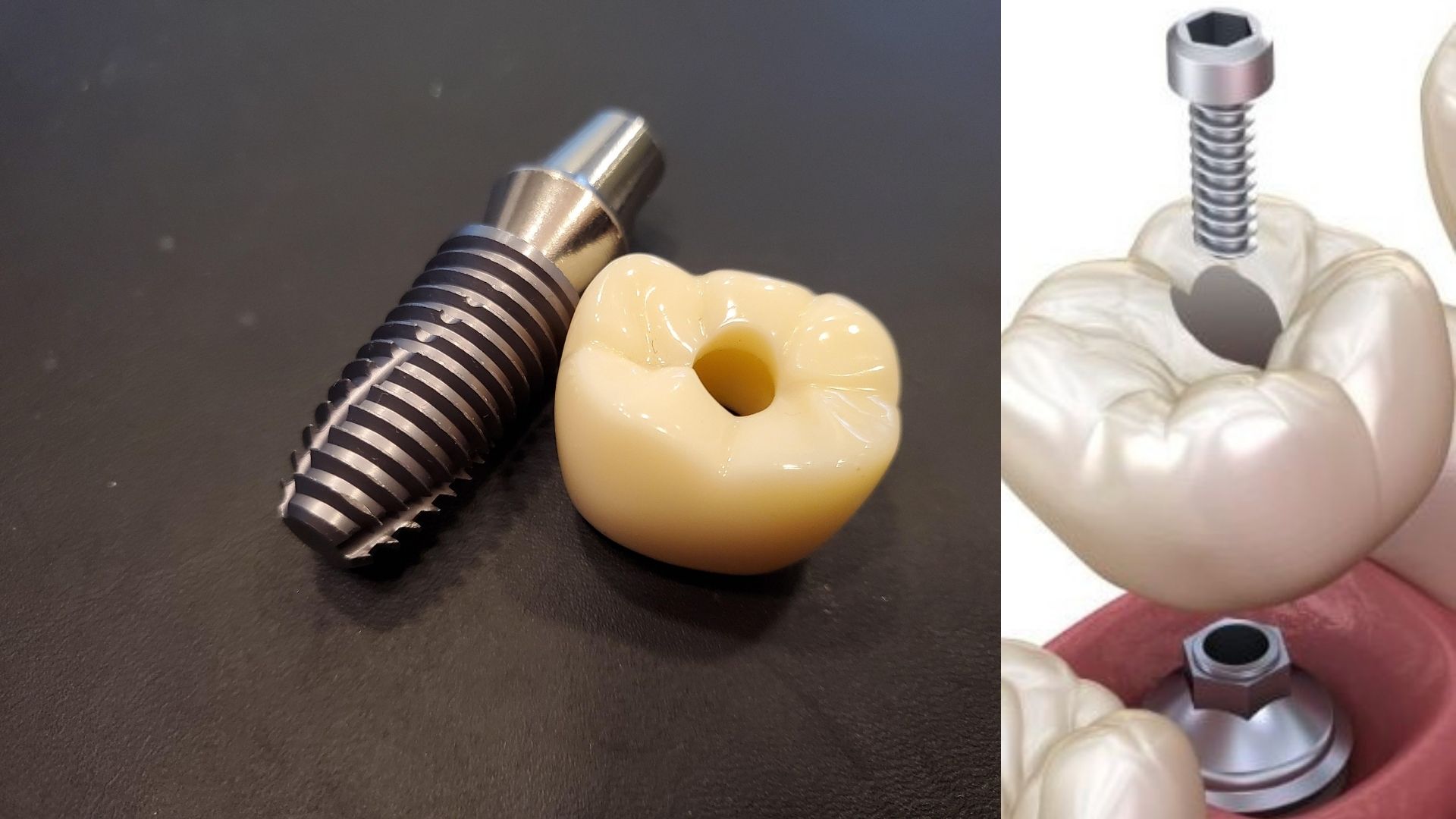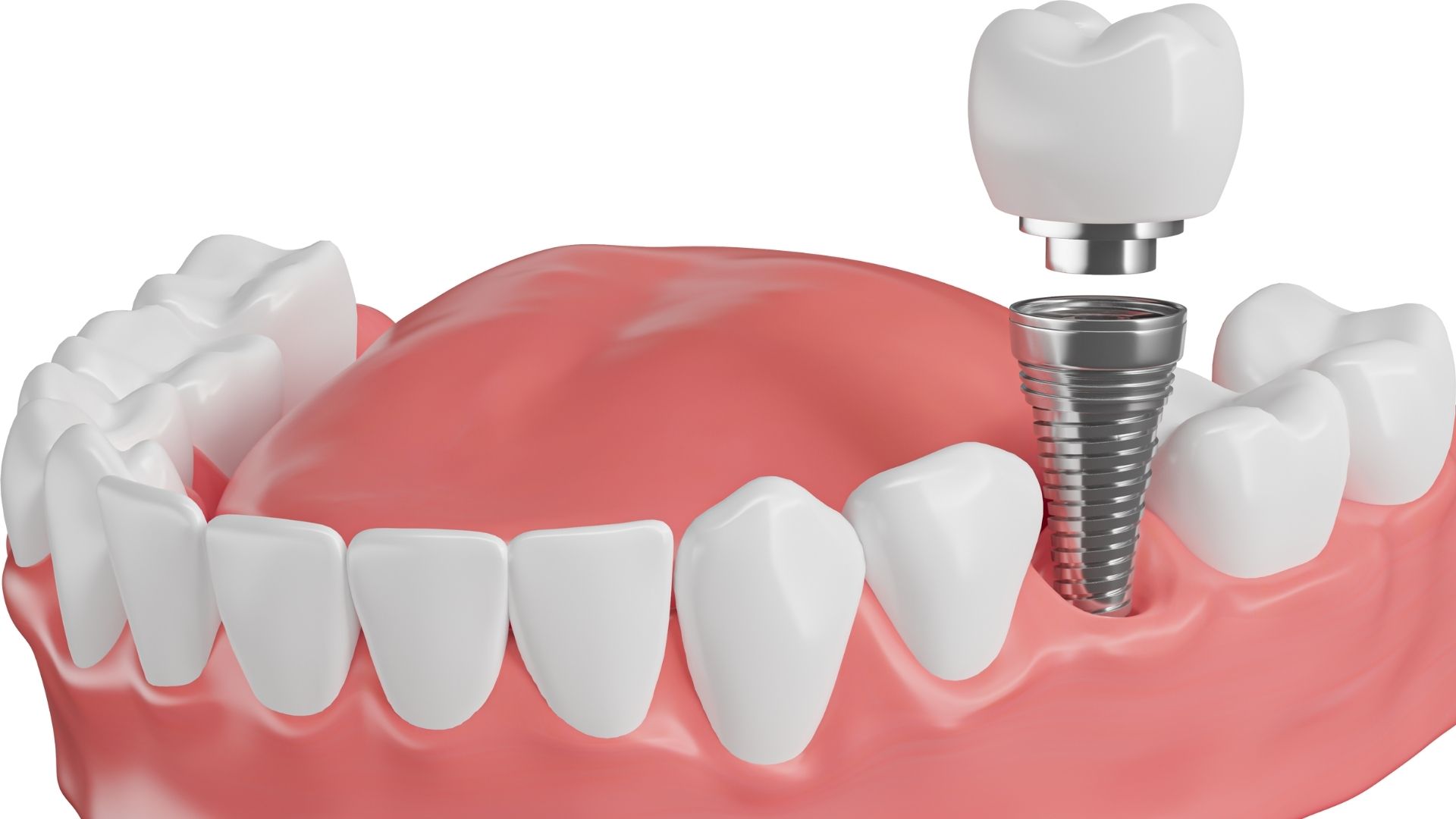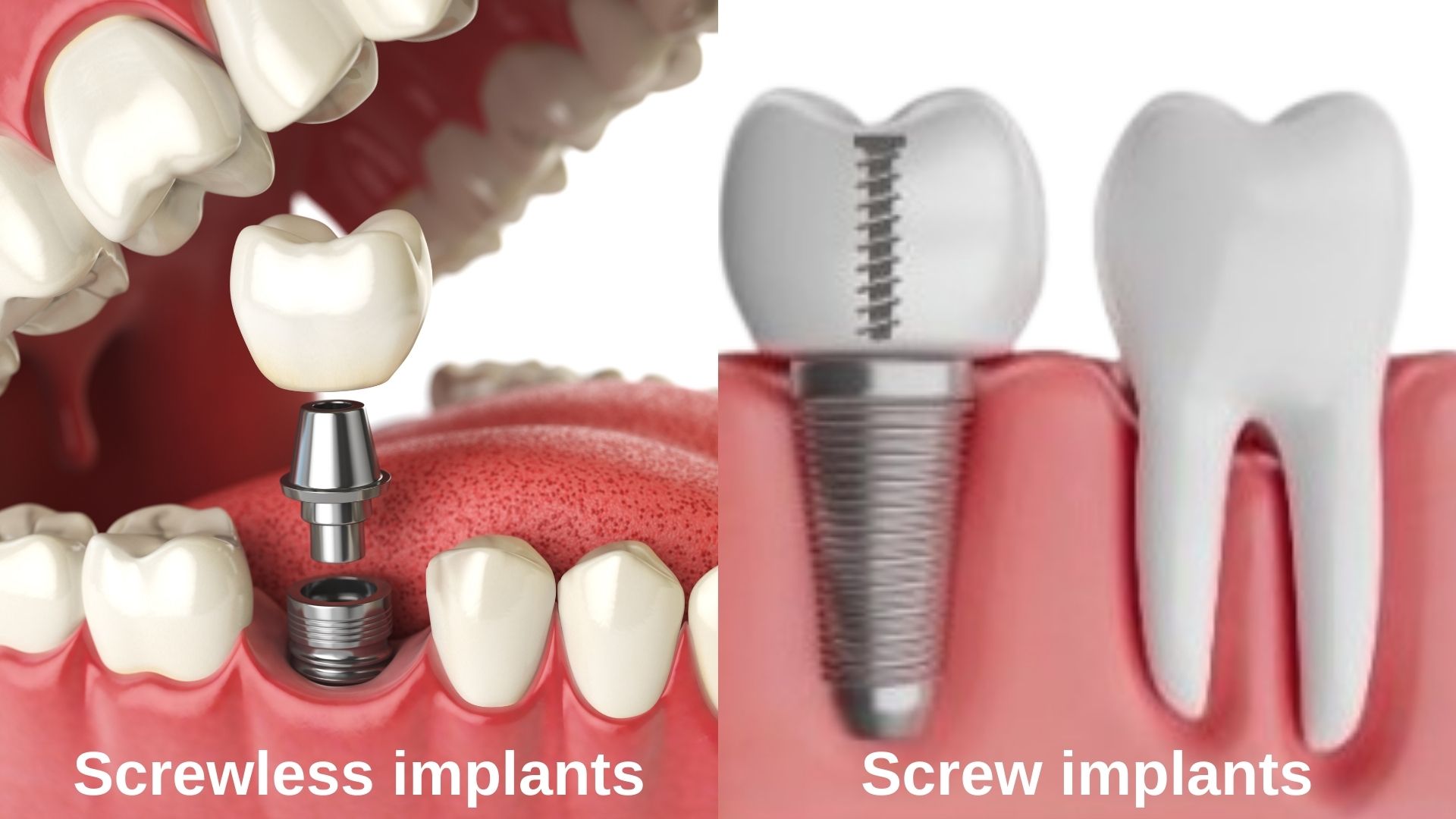What are screw implants?
They're small titanium posts that go into your jawbone and act like real tooth roots. Simple as that. Lost a tooth? This is how you give it a strong, steady base. Like screwing a table leg back on, it holds everything up again.
The screw shape isn't random. It helps the implant lock into the bone and stay put. No wobble, no slip! Over time, the bone actually grows around the implant.
Dental implant is not just about looks. When a tooth is gone, the bone starts shrinking. Implants stop that.
You eat, speak and smile like nothing's missing teeth. That's the magic of screw implants.

What are screwless dental implants/bonding implants?
They're dental implants too, and there's no screw hole on the crown. The implant bonds to the bone using a special surface or cement to hold the abutment. So how does it stay in place? It fuses, like glue on wood.
This implant does not have a spiral design. That's the other key difference from regular screw implants. It usually fits into a precisely made hole in the bone, requires no screws to hold the abutment, and the tight fit plus the bonding material holds it still. No rotation, no looseness.
Why use it? Occasionally the jawbone is too soft or too thin for a screw. In those cases, bonding implants can save the day. They're also quicker to place and reduce pressure on the bone.
Is it as strong as a screw implant? In many cases, yes. But not for everyone. Screwless options may not be ideal if your bone structure isn't great. It's like putting a nail in soft plaster; it might hold, but maybe not forever.

What are the differences between screwless implants and screw implants?
In the conventional screw implant system, the abutment and crown are connected to each other with internal screws. With a screwless implant, however, the abutment and crown are fixed together with a special adhesive. Although a screw is used in the screwless implant, this screw is used to fix the implant and the dental prosthesis (crown).
The feature that distinguishes the screwless implant from the screw implant is the use of adhesive instead of screws at the connection points. Thus, the screw is not visible from the outside. Therefore, the feature that distinguishes the screwless implant from the screw implant is the use of adhesive instead of screws to fix the crown.
Can dental implants be done without screws?
Yes, they can. With the screwless implants / bonding implants. These don't twist into the bone; they fit in and bond instead.
So, no turning! More like sliding a key into a perfect lock. The shape is usually smooth or slightly tapered. Dentists use special surfaces or adhesive materials to keep it stable.
But her's the thing: screwless implants don't work for everyone. The bone still needs to be healthy enough to hold them tight. They're helpful when the bone is too soft or thin for regular screw implants. Also good for people who want a simpler, less invasive option.
In the technique used in screwless implants, the implant site is prepared, and the implant is firmly placed in the bone. The crown and abutment are made to fit together; screws are not needed as in traditional implant treatments. Adhesive is used to better stabilise the crown-prosthesis connection.
Screw implant or screwless/bonding implant? The comparison of screw implant and screwless/bonding implant
|
Feature |
Screw implant |
Screwless/Bonding implant |
|
Placement method |
Twists into bone |
Press-fit or bonded |
|
Stability |
Very high |
Moderate to high |
|
Bone requirement |
Good bone densi-ty |
Precise bone shape |
|
Healing time |
Standard |
Sometimes shorter |
|
Common use |
Widely used |
Less common |
|
Long-term durabil-ity |
Proven and strong |
Depends on case |
|
Best for |
Most patients |
Select cases |
Screw implants twist into the bone like a bolt. They're super stable and work for most people. Screwless ones don't twist. They fit tightly and bond, kind of like a press fit.
Which holds better? Screws. Like a chair with real screws vs one snapped together.
Screwless implants are gentler on the bone and can be quicker to place. But they need perfect bone support and aren't as common.
Both are used to replace missing teeth. But the right one depends on your bone, your bite, and how long you want it to last. Always worth asking your dentist what fits you.
How do screwless dental implants work?
They work by fitting tightly into a hole in your jawbone - no twisting, no threads. The implant bonds with the bone through a special surface or cement.
No screw? Exactly. More like a peg that clicks perfectly into place.
The dentist creates a space that matches the implant's shape. Once implanted, the bone maintains its firmness. Over time, it heals and gets even more stable.
They don't twist into the bone like regular implants. Instead, they fit snugly into a space that's carefully shaped to match the implant's body. No threads, no turning. The surface of the implant bonds with the bone, either through a special coating or a kind of dental cement. That's how it stays in place.
Think of it like a LEGO piece snapping in! It doesn't move unless you pull hard. Same idea, just inside your mouth.
And since there's no screwing involved, it can reduce stress on the bone. That's helpful when the bone is softer or thinner. Plus, some screwless systems speed up the healing a bit because they cause less trauma during placement.
Can you get screwless dental implants? Are screwless dental implants suitable for everyone?
| Who's a good fit for screwless implants? |
| Strong, healthy jawbone |
| Bone thick enough |
| No major bone damage |
| Light chewing in that area |
| Tooth missing in front |
| Doesn't smoke |
| Doesn't grind teeth |
Yes, you can. Screwless implants work well but not for everyone.
So, who can get them?
Mostly people with healthy, dense bone and no major bite issues.
These implants need a super precise fit. The bone has to hold them tight, like a glove around your finger. If the bone's too soft, too thin, or has odd angles, it may not grip enough. That's when screw implants step in! They can handle more tricky spots.
Furthermore, screwless options often work better for front teeth. That's because those areas usually face less chewing force.
Back teeth? Not the best spot. Stronger pressure, higher risk of movement.
Your dentist will check your bone shape, strength, and even how you bite. It's a bit like shoe size; not one fits all.
So yes, screwless implants are an option. But only if the bone, the space, and the pressure are just right. They're sleek and simple and can heal fast.
How do screwless dental implants stay in place?
They stay in place thanks to a super tight fit and the bone's natural healing. The dentist creates a socket that matches the implant's shape almost perfectly. When placed, the implant presses gently into the bone. Over time, the bone grows around it and locks it in.
The process is like a puzzle piece clicking into the exact spot. Once it's in, it doesn't move.
What are advantages and disadvantages of screw-retained implants?
Advantages
- Easy to remove and repair
- No cement, so less risk of gum irritation
- Strong and stable connection
- Great for long-term use
Disadvantages
- Screw hole may affect looks
- Needs more space in the crown
- May loosen over time
- Can be harder to place perfectly in angled areas
What are advantages and disadvantages of screwless implants?
Advantages
- No screw hole on crown
- Looks more natural
- Less pressure on bone
- Quicker and simpler placement
Disadvantages
- Needs perfect bone fit
- Not ideal for strong bite areas
- Harder to remove if needed
- Limited long-term data compared to screws
How long do screwless dental implants last?
Screwless implants usually last 15 to 20 years. This period is sometimes even longer if everything goes well. Their lifespan mostly depends on bone quality, oral hygiene, and how much pressure they take daily.
Don't forget! Smoking, teeth grinding or poor care can shorten lifespan. On the other hand, regular check-ups, strong bone support, and good oral care help them last much longer.
Think of owning a good pair of shoes! If you treat them right, they'll stay with you for years.
How is a screwless implant done?
The whole thing starts after your dentist checks your X-ray and sees that the bone is good. You sit back. Local anaesthetic goes in, quick and easy. No pain, just a bit of pressure. Then the actual work begins.
So, if you're expecting drilling and twisting, no screw? This is different material and method.
The dentist gently opens the gum. Nothing dramatic, just enough to reach the bone. Then comes the most delicate part: shaping the bone to fit the implant. This step matters most. The hole has to match the implant's shape exactly. Not almost. Exactly fit. Think of it like a custom-cut groove for a key that only fits one lock.
Once that space is ready, the implant goes in with slight pressure. No spinning. Just a smooth, firm placement. The implant sits tight, like a peg pressed into solid wood. It doesn't wobble. It doesn't move.
Then the gum is closed sometimes with stitches, sometimes not. That's it. The implant stays hidden while the bone slowly grows around it. And that bond? That's what holds it in place for years.
Are there any risks or complications associated with screwless dental implants?
Yes. If the fit isn't perfect, the implant may loosen. Bone too soft? It may not hold well. Furthermore, it's harder to remove later if needed. But with the right case and good planning, risks stay low.
Are screwless dental implants cheaper?
Sometimes, yes. But not always. It depends on the system, the clinic, extra treatments and your bone. Fewer parts, lower cost!
Since there's no abutment screw, some setups cost a bit less. But precision matters more here, so the planning should be more detailed, and that balances out the price. Briefly? Experience of dentist!
It's like buying shoes. Slip-ons are usually cheaper. But if your foot needs extra support, you need to pay more for the right fit.
What is the cost of screwless dental implants compared to traditional implants?
Screwless implants can sometimes cost less than traditional screw-retained ones but not always.
Traditional implants usually include more parts: the implant, the abutment, the screw, and sometimes extra tools. That can raise the total cost. Screwless systems skip the screw and abutment, so fewer pieces might mean a lower price.
Fewer parts = cheaper? Sometimes yes, sometimes no.
But here's the thing: screwless implants need a very precise fit. So, the planning might take longer. That adds to the dentist's time and skill, which can affect the price.
Furthermore, traditional implants are more common. That means parts are widely available, and many clinics offer packages. With screwless types, some systems are newer or more niche, which can slightly raise the cost in certain places.
So, in short: screwless implants can be more affordable than traditional ones, but not always. It really depends on the technique, the clinic, and how complex your case is.
What are screwless mini dental implants?
They're small-sized implants that don't need screws to stay in place. Dentists place them into the bone with a tight press fit - no twisting, no threading.
Mini? Yes, thinner and shorter than regular ones.
They are used for narrow spaces or when the bone isn't thick enough. Think of them like tiny pegs that click into the bone and hold a tooth steady. Simple, smart, and gentle.
Why choose us for screwless implants?
Because your smile and teeth health deserve the best.
At Kuram Dental Clinic, we combine top-tier dental expertise with a warm, patient-centered approach. From veneers to implants, we use cutting-edge technology to ensure natural, long-lasting results. No stress, no hidden costs, just world-class dentistry in a comfortable setting.
Please contact Kuram Dental to get additional information.

